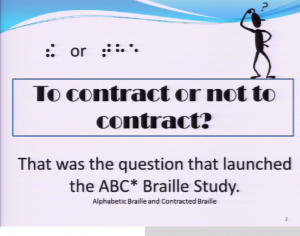Applying the Results of the ABC Braille Study to Real-Life Teaching: One Teacher's Interpretation

This presentation by Braille Literacy Consultant Anna Swenson was given at AER International in July 2012 is designed for teachers of students with visual impairments and summarizes the results of the ABC Braille Study, followed by a discussion of the implications for teaching braille to students in the primary grades.
The Alphabetic Braille and Contracted Braille Study (The ABC Braille Study) was the first longitudinal research focused on the acquisition of literacy skills by young children (pre-K through grade 4) who were learning to read in braille. The presentation focuses on four specific areas:
- When and how to introduce contractions to beginning readers
- The role of the teacher of students with visual impairments in teaching reading
- The importance of assessment in planning instruction
- Practical strategies for literacy instruction supported by the results of the ABC Braille Study.
The presentation emphasizes the need for teachers of students with visual impairments to focus on the full range of reading processes when they are working with young braille readers: phonemic awareness, phonics, fluency, vocabulary, and comprehension. Practical suggestions for introducing contractions, assessing literacy skills, teaching with leveled trade books, promoting fluency, and building vocabulary and comprehension are also included.
